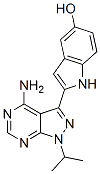All AbMole products are for research use only, cannot be used for human consumption.

Torkinib (PP242) is a first selective inhibitor that targets ATP domain of mTOR. PP242 displays selectivity for mTOR over other PI 3K family kinases (IC50 values are 0.102, 0.408, 1.27, 1.96 and 2.2 μM for p110γ, DNA-PK, p110δ, p110α and p110β respectively). PP242 induced ERK activation in MM cell lines as well as primary cells. PP242 could also inhibit phosphorylation of AKT on serine 473, a TORC2 substrate, while rapamycin was ineffective. PP242 was more effective than rapamycin in achieving cytoreduction and apoptosis in MM cells. In addition, PP242 was an effective agent against primary MM cells in vitro and growth of 8226 cells in mice. PP242 inhibits both S6K and 4EBP1 phosphorylation; activity causes a decrease in cap-dependent protein translation.

bioRxiv. 2024 Jun 28;14(7):999.
Functionality of BRCA1 supports the survival of prostate cancer cells during the development of castration resistance
Torkinib (PP242) purchased from AbMole
| Cell Experiment | |
|---|---|
| Cell lines | PC-3, SKOV3, 786-O, and U87 cells |
| Preparation method | In vitro proliferation and drug combination experiments. Cells were seeded in triplicate wells of 96-well flat bottom culture plates for 48 hr in the presence of increasing concentrations of indicated inhibitors. Cell viability and median-effect dose affecting growth (GIC50) was determined using the MTS assay (Cell Titer 96 Aqueous One solution cell proliferation assay kit; Promega). Absorbance values (490 nm) were normalized to controls and expressed as %MTS conversion. Wells lacking cells but with MTS added were used as the zero value when normalizing. For drug combination experiments, a range of fixed ratios of inhibitors was used to assess synergy using the combination index (CI) with CalcuSyn software (Biosoft) according to the median-effect method as previously described 2. For proliferation experiments with PC-3, SKOV3, 786-O, and U87 cells, the CellTiter-Glo Luminesecent reagent (Promega) was used following the manufacturer’s instructions. Quantitation was performed as mentioned above. |
| Concentrations | 0~10 μM |
| Incubation time | 48 h |
| Animal Experiment | |
|---|---|
| Animal models | xenograft experiments with human Ph+ leukemia |
| Formulation | PEG400 or 5% NMP, 15% PVP, 80% water |
| Dosages | 60mg/kg once daily |
| Administration | oral |
| Molecular Weight | 308.34 |
| Formula | C16H16N6O |
| CAS Number | 1092351-67-1 |
| Solubility (25°C) | DMSO 50 mg/mL |
| Storage |
Powder -20°C 3 years ; 4°C 2 years In solvent -80°C 6 months ; -20°C 1 month |
[2] Hoang B, et al. Blood. Targeting TORC2 in multiple myeloma with a new mTOR kinase inhibitor.
| Related mTOR Products |
|---|
| RMC-4627
RMC-4627 is a selective mTORC1 inhibitor that activates 4EBP1 and inhibits tumor growth. |
| RMC-4529
RMC-4529 has an IC50 value of 1.0 nM against p-4E-BP1-(T37/46) in mTOR kinase cellular assay. |
| WYE-687 dihydrochloride
WYE-687 dihydrochloride is an ATP-competitive mTOR inhibitor with an IC50 of 7 nM. |
| Rapamycin-d3
Rapamycin-d3 |
| L-Leucine-d10
L-Leucine-d10 |
All AbMole products are for research use only, cannot be used for human consumption or veterinary use. We do not provide products or services to individuals. Please comply with the intended use and do not use AbMole products for any other purpose.


Products are for research use only. Not for human use. We do not sell to patients.
© Copyright 2010-2024 AbMole BioScience. All Rights Reserved.
